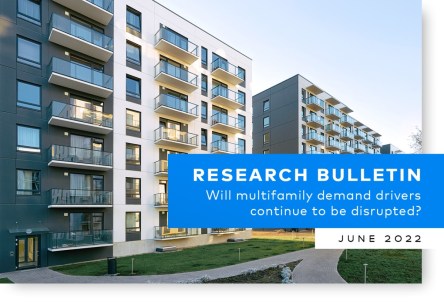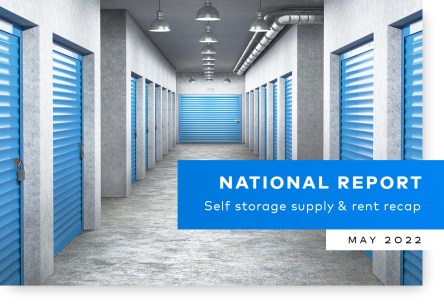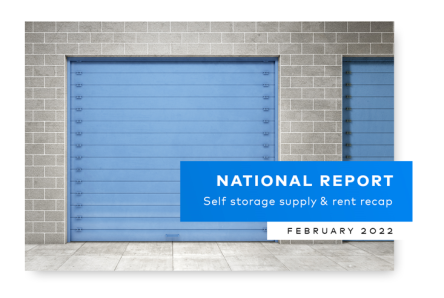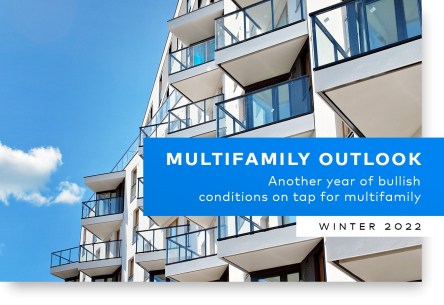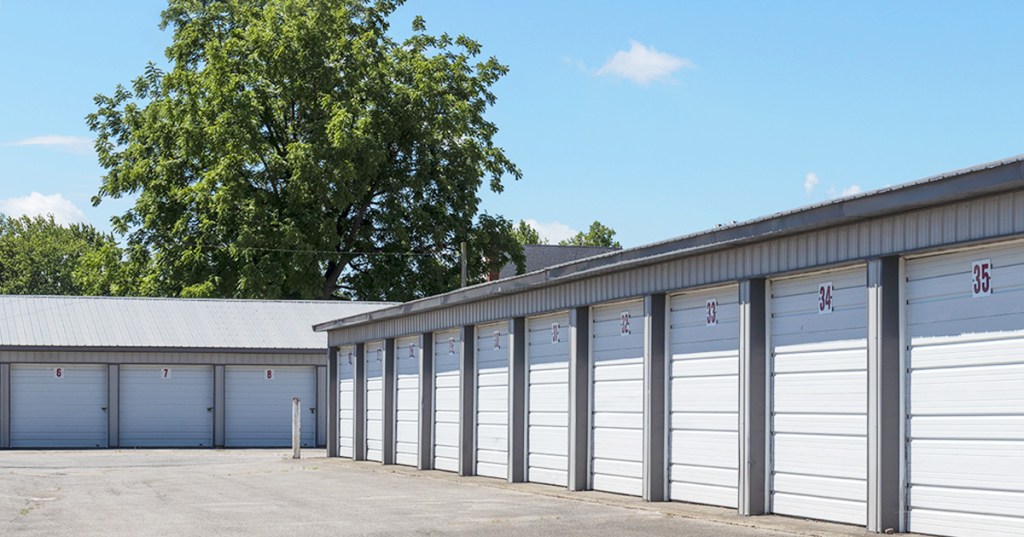The national outlook for the multifamily sector remains positive through the end of 2022, with asking rent performance expected to have increased by around eight percent by year’s end. That’s according to the latest U.S. Multifamily Outlook report released today by Yardi® Matrix, a leading provider of data and analysis on most real estate verticals. The report examines the state of the economy, including ongoing inflation and recession concerns, but concludes that though rent growth is slowing down, gains are expected to continue. Average national asking rents increased 5.7 percent in the first six months of the year. Year-over-year rent growth at the year’s midpoint was 13.7 percent, down 100 basis points from the end of 2021 and 150 basis points from the February peak of 15.2 percent. “While growth is moderating, we expect gains will continue to remain well above trend, with average asking rents increasing by 7.9 percent nationally by the end of 2022,” states the forecast. However, the increases are far from 2021’s record 14.7 percent increase. Property fundamentals continue to be exceptional, with demand driven by robust household formation, job growth, migration to suburbs and secondary markets, and the inaffordability of single-family homes for many would-be buyers. More than 900,000 new multifamily units are under construction nationally, with 420,000 expected to be delivered this year. Gain more insights about expectations for the remaining months of 2022 in the latest Matrix Multifamily Outlook. Yardi Matrix offers the industry’s most comprehensive market intelligence tool for investment professionals, equity investors, lenders and property managers who underwrite and manage investments in commercial real estate. Yardi Matrix covers multifamily, student housing, industrial, office and self storage property types. Email [email protected], call (480) 663-1149 or visit yardimatrix.com to learn...
Multifamily Update
Yardi Matrix Report
Average U.S. multifamily rents rose another $19 in June to edge over $1,700 for the first time ever, according to the latest Yardi® Matrix Multifamily Report. The increase was fueled by strong demand and rent growth throughout the country. Rent growth increased at least 10 percent year-over-year in 25 of Yardi’s top 30 metros. National occupancy rates were solid at 96 percent. On a year-over-year basis, growth continues to slow down. In June, it decelerated by 50 basis points to 13.7 percent. That’s 130 basis points off the February peak of 15.2 percent. Rents in the single-family build-to-rent (BTR) sector continue to grow as well. The average single-family BTR asking rent increased by $23 in June to an all-time high of $2,071. Year-over-year growth dropped by 90 basis points to 11.8 percent. “The multifamily market is starting to show signs of deceleration in June but is still performing at extremely high levels. Year-over-year rent growth was down 50 basis points from May. While rent growth in 2022 is still higher than any previous year on record, it is the fourth month in a row year-over-year rent growth declined,” note Matrix analysts. The expectation for the remainder of 2022 is for rents to increase at slower rates as the economy cools off. “Inflation rates will take a while to ebb, causing consumers to cut into savings and their ability to afford increasing rental rates will lessen as the year goes on,” states the latest report. Learn more in the latest multifamily report. Yardi Matrix offers the industry’s most comprehensive market intelligence tool for investment professionals, equity investors, lenders and property managers who underwrite and manage investments in commercial real estate. Yardi Matrix covers multifamily, student housing, industrial, office and self storage property types. Email [email protected], call...
National Rent Growth
Projections Bump Up
Rents in most American cities continue to rise slightly each month but are not duplicating the rapid escalation rates exhibited in 2021. But given ongoing gains, Yardi Matrix has revised its end-of-year projections upwards for most markets in a new special report. Average month-over-month asking rents increased by 1.1 percent in May compared to the one percent month-over-month increase in April. However, year-over-year asking rents decelerated, from 16 percent in April to 14 percent in May. “While we are seeing the usual seasonal increase leading into the summer months, 2022 does not look like a repeat of 2021 even though rent growth remains elevated,” state Matrix analysts. Asking rents fell in only six markets: the gateway markets of Queens and Brooklyn; small Southern markets Macon, Ga., and Jackson, Miss.; and tropical Honolulu and the Southwest Florida Coast. Conversely, 84 markets experienced greater than one percent month-over-month increase, and seven markets saw month-over-month growth that topped two percent: Charleston, Knoxville, the Bay Area-South Bay, Miami, the Urban Twin Cities, Wilmington, N.C., and Portland, Maine. Most markets received an increase to their end-of-year projections in the newly released Matrix report. The biggest increases were concentrated in markets that continue to outperform expectations, with Scranton-Wilkes-Barre, Wilmington, South Bend and Spokane all seeing a more than five percent increase for year-end 2022. The nation’s economic outlook plays an important role in rent forecasts. That outlook has become increasingly tumultuous, with inflation at a 40-year-high but unemployment historically low. Analysts are continuing to keep a close eye on the market and monitoring the impact of the Federal Reserve’s approach to combatting inflation as well as the war in Ukraine. “The Fed will likely ramp up its pace of rate hikes and quantitative tightening, increasing the chance of recession for...
Storage Steps Up
Yardi Matrix report
Self storage continues to see rents tick up month after month, despite growing economic turmoil, according to the latest National Self Storage Report from Yardi® Matrix. Overall street rates rose $1 last month to $147, with 10X10 climate controlled units averaging $149 and 10X10 non-climate controlled units at $131. “Storage demand remains extremely resilient, enabling operators to push both street rates and renewal rates while maintaining occupancy,” say Matrix analysts. The demand drivers for self storage are many, but current trends include the need for work-from-home space, retail spending on furnishings and consumer goods, migration and rising cost of housing. “Some households may choose to save money by living in a smaller apartment while renting a storage unit on the side. Inflation is a growing concern as it squeezes consumers’ budgets, but some operators say it also braces them to expect rent increases,” notes the report. Even as street rates hit record highs and demand remains strong, year-over-year growth is moderating as anticipated. The total average annual street rate growth fell 150 basis points to 3.5 percent in May, a continued deceleration from the standout gains of 2021. However, growth remains healthy relative to the long-term average. Yardi Matrix tracks a total of 4,066 self storage properties nationwide in various stages of development — including 1,481 planned, 750 under construction and 522 prospective properties. Matrix also maintains operational profiles for 28,390 completed self storage facilities across the United States, bringing the total data set to 32,456. Learn more about the state of the self storage market...
Pandemic Impact
On multifamily rents
The unprecedented socioeconomic events of the last two years and subsequent impact on multifamily rents is examined by a new bulletin from Yardi® Matrix now available for download. The publication breaks down the traditional drivers of multifamily rent growth—economic measures such as employment and population growth, and property fundamentals such as supply and changes in occupancy—and details how each impacted the highs and lows rents exhibited from March 2020 to April 2022. The analysis is broken into two periods: the four quarters following the start of the pandemic (2Q20 to 1Q21) and the four quarters of the recovery and rent surge (2Q21 to 1Q22). “Drivers of rent growth have changed not only once, but twice, in the two years post-pandemic. Each time was distinctly different,” states report author Paul Fiorilla, director of research for Yardi Matrix. “The period from April 2020 through March 2021 was marked by massive job loss, sheltering from home and migration from gateway markets to the Sun Belt. The April 2021 to March 2022 period was characterized by a booming pent-up demand and massive recovery across the entire country.” If you’ve been following the apartment industry closely, the general narrative of the pandemic is clear: motivated by remote work options and changes in life circumstances, many renters abandoned high-cost urban gateway markets in favor of more affordable cities with more room to breathe. Major cities like San Francisco, Chicago and New York saw rents drop dramatically and vacancy rates increase. After vaccine availability brought stabilization of the public health situation and widespread economic recovery ensued in 2021, return to gateway markets began and rents across nearly all markets were driven up by new household formation, low vacancy rates and easily obtainable employment. “Pent-up demand, strong consumer balance sheets, migration to...
Multifamily Update
From Yardi Matrix
Multifamily performance continues to outpace every year other than 2021, according to the latest Yardi® Matrix Multifamily Report. Average U.S. asking rent rose $19 in May to an all-time high of $1,680. Year-over-year growth decelerated by 40 basis points to 13.9 percent. That’s 130 basis points off the peak in summer 2021, but still exceptional performance, according to Matrix analysts. “Decelerating economic growth and concerns about gas prices and inflation have not eroded multifamily demand much nor slowed down the upward climb of rents,” say Matrix analysts. Rent growth in recent months is consistently a bit less than it was in 2021, but considerably above any previous year and spread across the country. Rent growth rose at least 10 percent year-over-year in 26 of Yardi’s top 30 metros. The biggest gains were recorded in rapidly growing Sun Belt metros. Miami, Orlando and Tampa are all above 20 percent growth year-over-year. The Twin Cities, at 5.2 percent year-over-year, was the only metro in the Matrix top 30 with rent growth below 8.7 percent. Meanwhile, the average single-family home asking rent also increased by $19 in May to $2,038, as year-over-year growth dropped by 70 basis points to 12.7 percent. The single-family rental sector is expected to continue to ride strong demand, especially as home sales slow due to higher interest rates. Learn more in the latest multifamily report. Yardi Matrix offers the industry’s most comprehensive market intelligence tool for investment professionals, equity investors, lenders and property managers who underwrite and manage investments in commercial real estate. Yardi Matrix covers multifamily, student housing, industrial, office and self storage property types. Email [email protected], call (480) 663-1149 or visit yardimatrix.com to learn...
Self Storage Update
Sector demand continues
Self storage continues to perform well nationwide according to the latest National Self Storage Report from Yardi® Matrix. National average storage rates rose $1 to $146 in April, matching the all-time high set last fall. Street rate growth, however, is decelerating because rates increased more dramatically in 2021. Street rates for 10×10 non climate-controlled units nationally increased 4.8 percent year-over-year in April, while rates for 10×10 climate-controlled units saw slightly less growth at 4.3 percent. According to industry executives at the NYSSA investment forum this month, demand comes not only from normal factors like migration and student movement, but also from individuals who need storage to accommodate offices and businesses that have been squeezed out of the tight commercial market. Storage customers are renewing at high rates and extending the length of stays. It all results in growth in rents and net operating income, which has increased upwards of 20 percent for some REITs over the past year. However, market headwinds do exist. Consumer demand that has driven the recent boom could cool as higher interest rates slow migration and dampen home sales, which are major drivers for self storage. And although storage has a limited amount of capital expenditures, increasing expenses for items such as labor and materials may erode benefits of strong rent growth. “Storage executives, however, are confident the segment is uniquely well positioned in an inflationary environment because leases can keep pace with rising prices and they foresee an ongoing increase in demand,” states the report. Yardi Matrix tracks a total of 4,051 self storage properties nationwide in various stages of development — including 1,467 planned, 747 under construction and 526 prospective properties. Matrix also maintains operational profiles for 28,289 completed self storage facilities across the United States, bringing the...
Matrix Trading Bulletin
Multifamily Sale Prices Jump
Real estate investors are gung-ho on multifamily – so much so that last year they were willing to pay more for it than ever before, especially in certain circumstances. Whether that trend continues or a bubble burst is on the horizon is the focus of a new Multifamily Trading Bulletin from Yardi Matrix. Record-high property sales and prices were recorded in 2021. Yardi Matrix tracked $215 billion of multifamily property sales in the U.S. in 2021 that traded for an average of $192,105 per unit, a year-over-year increase of 21.6 percent. The new bulletin analyzes repeat sales over the last decade in Matrix’s database of 83,000 properties. Among those, 4,500 multifamily properties in the US — about 5.3 percent – sold at least three times over the last decade. The average compound annual growth rate for the repeat-sale properties averaged 17.7 percent nationally. Analysts found that rents rose rapidly during the 10-year cycle, but not as much as price appreciation. Multifamily rent growth in 2021 was up 14 percent for the year, a record, but rent growth has been above the long-term average for over five years (except for during COVID-19 lockdowns). “The rapid growth in pricing reflects a combination of factors: the exceptional amount of liquidity in real estate and multifamily, the extremely strong rent growth, the low cost of financing as interest rates bottomed and debt costs were near historical lows, and the optimism about the sector’s prospects in the next few years,” says Paul Fiorilla, director of research for Yardi Matrix, who authored the bulletin. Deal flow roared back in 2021 to a record $215.3 billion, a 67.3 percent increase from the prior high point in 2019. 2021 also set new records with 6,488 properties sold and 1.34 million units traded. “The extraordinary increase in pricing likely to be threatened going forward by the increase in interest rates and questions about the economy, which has already prompted a slowdown in investment activity and will likely end the period of appreciation growth,” Fiorilla stated. What sort of assets are driving these increases? Investors know what they like, and that includes smaller assets in secondary markets geared toward working-class renters. They are considered to have rent-growth potential due to relatively low rents and location in markets with above-trend rent growth. They will also pay a premium for strategically located value-add properties. The most popular regions include secondary markets and areas with strong in-migration, particularly Texas, the Southeast and Southwest, where demand and rent growth is growing faster than the rest of the nation. Relatively few properties in gateway markets made the list of repeat sales. Yardi Matrix tracks properties in 162 markets with 50 or more units. Gain more insights from the new Multifamily Trading Bulletin from Yardi...
Bumpy Roads Ahead
Multifamily Webinar Recap
As the stock market rocks and rolls, inflation becomes a fact of life and many Americans continue to relocate, what’s in store for the multifamily industry? Answering that big question was the goal of a recent Yardi Matrix webinar presented by Jeff Adler, vice president of Matrix, who presented fundamentals, economic indicators, geographic trends and much more. If you missed the presentation, you can view the recording and slide materials. Additional multifamily insights are available in the latest Yardi® Matrix Multifamily Report, which reported this week that the average U.S. asking rents rose $15 in April to an all-time record $1,659. Multifamily asking rent growth measured a record 14 percent increase in 2021. However, that performance is expected to moderate during the remainder of 2022, due to multiple factors. “I do expect the economy to continue to grow – at a slower rate. I do expect multifamily to continue to grow – at a slower rate. Bottom line, it is going to be bumpy,” Adler said. On the plus side, multifamily fundamentals are strong, and the sector should remain resilient during the next year and beyond. Beyond external factors like inflation, rising interest rates and economic volatility, there are many trends impacting housing that investors and multifamily professionals should make note of. They include: Ongoing population migration: “The hybridization of the work force and the ability to work from anywhere has enabled a spreading of the population,” said Adler. That has been beneficial for secondary and tertiary markets over gateway markets. Find out which ones in the presentation materialsLease renewals: While multifamily asking rents have jumped 20-25 percent over the last year in most markets, lease renewals are more likely to ask for about 10 percent more per month, Adler stated. That means many...
Student Housing
Yardi Matrix Update
Despite a widely reported drop in college enrollment over the last two years, the student housing industry continues to perform well and is back on track with healthy rent growth and preleasing for Fall 2022. Those were a few of the topline conclusions of a webinar focused on student housing, presented April 13 by Yardi Matrix vice president Jeff Adler. Miss the session? You can view the recording and presentation materials. Overall, up to one million students who were expected to attend college in the U.S. are now missing from enrollment rolls. That’s a significant reduction that will have myriad impacts, from college finances to housing to career prospects. “If you look at the straight from high school to college enrollment, we thought we would see a gap year (in 2020-2021), but it turns out the gap year was an off-ramp,” said Adler. That off-ramp has been detrimental to lower-tier four-year colleges and community colleges. But within the Yardi 200, comprised of the top 200 investment grade universities across all major collegiate conferences, enrollment is up and is expected to continue to be up at a modest rate over the next several years. That’s due to consolidation of enrollment, Adler explained. “If there are fewer (students) available, and you want to get into a school that has a higher reputation, then the name brand schools are the ones that are the winners,” he said. That largely includes the 42 private and 158 public schools that comprise the Yardi 200. As of March, preleasing for next fall was recorded at 63.7 percent across Yardi 200 schools. That’s 13.5 percent higher than the same time last year and 9.9 percent higher than March 2019, before the pandemic. The average rent per bedroom is $777 for Fall...
Multifamily Update
From Yardi Matrix
Prolonged inflation and the war in Ukraine are beginning to impact U.S. economic growth and rent performance as well, according to the latest Yardi® Matrix Multifamily National Report. Average U.S. asking rents rose $14 in March to an all-time high of $1,642. However, year-over-year growth dropped 50 basis points to 14.8 percent – an indication that rents are beginning to slow after 2021’s record-shattering performance. “Rent growth is unlikely to keep pace with 2021, as last year’s explosive movement started in the second quarter,” state Matrix analysts. Rents for single-family rentals continue to rise month-over-month, but growth is also decelerating in that subsector. The average U.S. single-family rent rose $14 to $1,999 in March, while year-over-year growth dropped 90 basis points to 14.1 percent. Rent growth continues to be led by population shifts to the Southeast and Southwest. Miami, Orlando, Tampa, Las Vegas and Phoenix all recorded asking rent increases of 23 percent or more in March. “The big picture that emerges from March multifamily data is that the market remains healthy, though signs point to the inevitable deceleration in some markets,” states the report. “Meanwhile, economic conditions and global events contain headwinds that justify the expectations of moderation and caution.” Gain additional insights from the Yardi Matrix Multifamily National Report. Join Matrix on Thursday, May 12 for a deeper dive into the current state of the multifamily market. Get more details and sign up...
RV/Boat Storage
New Report from Yardi Matrix
Yardi Matrix recently added a new sector to its property management database: storage facilities for the fast-growing recreational vehicle and boats market. Matrix enters the market as RVs and boats reach new heights of popularity. Sales of exclusive facilities for these assets exceeded $157 million last year, almost triple the previous annual record, as Americans sought travel and recreation opportunities away from crowds. And there’s no sign of a letup – some 9.6 million households say they intend to buy an RV within the next five years. Meanwhile, new powerboat retail unit sales this year are expected to surpass the 300,000 sold in 2021 by up to 3%. A driver of RV/boat sales is “the healthy balance sheets of households as people stopped spending while sheltering in place and collected stimulus checks from the government,” according to a Matrix bulletin issued in March. In addition, “the pandemic helped stoke a growing appreciation for recreation and travel to rural settings.” The Matrix RV/boat storage facility database encompasses 786 completed storage facilities exclusively dedicated to RVs and boats, with more than 6,800 acres of space and 35 facilities in the development pipeline. Matrix identifies Denver, Houston, San Francisco, California’s Inland Empire, Los Angeles, Dallas and Phoenix as top markets for RV and boat storage properties. Looking ahead, Matrix regards RV and boats as a “durable part of the American experience” that’s likely headed for even more growth. Demand is met with a somewhat limited offering of supply, with only 88 properties in the Matrix database having been delivered since 2010, compared with about 225 between 2002 and 2009. Even so, the market is sturdy. “The growing demand from RV and boat sales combined with the limited amount of supply means the segment’s fundamentals should remain healthy,...
Multifamily Update
New Yardi Matrix Report
Multifamily asking rents picked up another $10 in February to reach a national average $1,628, and year-over-year growth recorded a 15.4 percent bump, according to the new Yardi Matrix Multifamily National Report. Single-family rentals also continue to surpass past performance, SFR rents increased by 14.9 percent year-over-year through February. While most anticipated that the steep upward trajectory for the rental sector would have moderated in the first quarter of 2022, the market continues to surprise. Of the top 30 metros tracked by Yardi Matrix, 90 percent saw double-digit rent growth year-over-year. “Rent growth is likely to start decelerating soon relative to the big increases that began in March 2021, but demand shows little sign of slowing,” say analysts. Nationally, occupancy rates are up 120 basis points year-over-year. Occupancy upticks are particularly strong in Texas and Florida metros, but also in gateway markets that lost residents during the pandemic. New York, San Jose and Chicago are among the cities seeing renters return. Underlying the headlines are the effects of a long-term national housing shortage, notes the report. In January 2021, occupancy rates were 95 percent or higher in just 13 of the top 30 markets, but a year later only two of the top 30 are below that level. In another telling indicator, single-family home sale prices were up an average of 18.8 percent last year. Learn more in the latest Yardi Matrix Multifamily National Report. Yardi Matrix offers the industry’s most comprehensive market intelligence tool for investment professionals, equity investors, lenders and property managers who underwrite and manage investments in commercial real estate. Yardi Matrix covers multifamily, student housing, industrial, office and self storage property types. Email [email protected], call (480) 663-1149 or visit yardimatrix.com to learn...
State of Self Storage...
Yardi Matrix Webinar Recap
The self storage sector continues to weather economic conditions that are likely to become more challenging in the near term, attendees of a webinar presented this week by Yardi Matrix learned. “There are several headwinds that might be getting a bit stronger,” said Jeff Adler, vice president of Yardi Matrix, during the Wednesday presentation. Supply chain disruptions, a tight labor market and inflationary pressure, in addition to the geopolitical tensions between Russia and Ukraine, will all slow economic growth in the U.S., Adler said. A recording of the webinar and presentation materials are now available for download. However, despite the potential of a looming recession that Adler expects will arise by late 2024, the overall outlook for the self storage sector is healthy at present. “The outlook for self storage remains optimistic given persistent demand and a slow supply response. We anticipate growth will continue, but moderate,” Adler said. “Investor interest is incredible in the sector, given its performance and defensive nature, which has proven itself out.” Matrix analysts expect that self storage street rates will continue to grow in 2021, just at a more modest rate. Additional high level takeaways from the webinar include: Street rate growth will continue to be highest in favored migration areas, such as the Sunbelt and mountainous areas of the WestDriving forces of demand will continue, including: people are still relocating, just at a slower rate; Americans have accumulated “stuff” during the pandemic that needs to be stored; and self storage remains the cheapest way to store accumulated possessions Self storage street rates changed little sequentially in January, reflective of positive trends in the industry, and rents remain well above trend on a year-over-year basis, according to the latest Yardi® Matrix National Self Storage Monthly report. Year-over-year rent...
Storage Stays Strong
New Matrix Report
Despite a slight seasonal dip in occupancy, the self storage sector is beginning the year with a continuation of the strong fundamentals that fueled its success in 2021. Self storage street rates changed little sequentially in January, reflective of positive trends in the industry, and rents remain well above trend on a year-over-year basis, according to the latest Yardi® Matrix National Self Storage Monthly report. Street rates for 10×10 non-climate-controlled (NON CC) units were unchanged at $128 in January. National street rates for 10×10 climate-controlled (CC) units decreased by $1 in January to $145. Year-over-year, street rates for 10×10 NON CC units grew 7.6 percent in January, while rates for 10×10 CC units grew 7.4 percent. “Operators report that occupancy rates have dipped slightly as move-outs have increased in recent months, but that is not worrisome because properties were unusually full going into the traditional winter lull,” say Matrix analysts. Year-over-year rent growth remains positive in all major metros, with 11 of the top 32 metros at 10 percent or more growth and 25 of the top 32 at 5 percent or more growth for NON CC units. Rent increases continue to be highest in the Sun Belt and the Southwest, with demand fueling notable jumps in Texas, Florida and the Carolinas. “Rates are holding firmer than historically is the case” in the winter, said John Good, CEO of NexPoint Storage Partners, during an industry webinar. Yardi Matrix tracks a total of 3,831 self storage properties nationwide in various stages of development — including 731 under construction, 1,287 planned and 520 prospective properties. Matrix also maintains operational profiles for 27,298 completed self storage facilities across the United States, bringing the total data set to 31,129. Learn more about the state of the self storage...
Rents Gain Again
Multifamily Report
Multifamily asking rent gains continued in January, rising $8 to a U.S. average of $1,604, according to the latest Yardi Matrix Multifamily National Report. The latest gain defied normal seasonal expectations and continued a trend established last year, a historic period for multifamily asking rent growth. Year-over-year, rents increased 13.9 percent. While rents are unlikely to remain in that growth range throughout 2022, January’s performance is a sign that demand remains healthy. Some 460,000 multifamily units were absorbed in 2021, according to Yardi® Matrix data, more than double the previous year and more than 50 percent above the previous annual high. Absorption in 2021 was led by Dallas and Houston. Five of the next six highest performers were gateway metros Miami, New York, Chicago, Washington and Los Angeles, all of which absorbed some 20,000 units or more. Freddie Mac’s 2022 multifamily outlook sums up the market: “The strong economic conditions along with unprecedented levels of demand for multifamily housing have combined to create robust apartment market conditions in 2021,” the report said. “While there are still uncertainties, such as increasing inflation or more transmissible variants of the COVID-19 virus … the multifamily market is expected to be on solid ground in the short term.” Learn more in the latest Yardi Matrix Multifamily National...
Multifamily Outlook
Winter 2022
The multifamily market appears poised for another solid year in 2022, according to the U.S. Multifamily Outlook for Winter 2022, released today by Yardi® Matrix. While the record-setting rent gains recorded in 2021 are not expected to repeat this year, analysts anticipate demand for apartments will remain robust, highlighted by strong economic growth and household formation. Investor activity is also expected to continue apace, as capital conditions look favorable and multifamily traditionally offers stable income and low mortgage rates. Powering the positive outlook is the continued strength of the economy and consumer demand. “The economy is benefiting from lingering monetary stimulus, job growth, higher wages and consumer wealth, while supply-chain issues have continued into 2022. Inflation and the labor shortage are the biggest headwinds, but most of the negative ramifications from those matters won’t be felt until 2023 or later,” states the new report. Asking rents rose 13.5 percent nationally in 2021. Anticipated rent growth for 2022 is less than 5 percent, according to Matrix. Economic growth is also expected to step back from the roughly 6 percent increase it recorded last year. Concerns about oversupply have also so far proven to be unfounded and builders are ramping up for new projects nationwide. As of the beginning of 2022, more than 750,000 market-rate apartment units were under construction, with about half expected for delivery this year. Learn more about what’s expected for multifamily in 2022. Yardi Matrix offers the industry’s most comprehensive market intelligence tool for investment professionals, equity investors, lenders and property managers who underwrite and manage investments in commercial real estate. Yardi Matrix covers multifamily, student housing, industrial, office and self storage property types. Email [email protected], call (480) 663-1149 or visit yardimatrix.com to learn...
Self Storage Update
From Yardi Matrix
Street rates for self storage properties are coming off record-high gains in 2021, and experts are optimistic the sector will continue to perform well in 2022, according to the latest National Self Storage Monthly Report from Yardi® Matrix. Year-over-year, national rates for 10×10 non-climate-controlled (NON CC) units increased 6.7 percent in December. Rates for 10×10 climate-controlled (CC) units increased 7.4 percent. However, month-over-month, street rates for 10×10 NON CC units declined nationally by $1 to $127 in December. National street rates for 10×10 CC units declined by $1 for the third straight month to $145. While performance is dropping back from major gains made during the summer, the growth rates are well ahead of where they were in December 2020, when national year-over-year increases were between 2-4 percent for all unit types. The reasons for optimism include the traditional “4Ds” of self storage demand: death, divorce, dislocation and disaster. Owners/managers see demand not only from those traditional drivers, but from two new Ds: decluttering and distribution/business demand. Executives who participated in a panel at the recent KeyBanc Capital Markets 2022 Self Storage Investor Forum all were optimistic about demand, rent growth and capital trends in the year ahead. One commented: “As we look back on 2021 I consider it the greatest year to date in the storage industry. 2022 will be a good year for our business.” Most operators will start spring leasing season with exceptionally high occupancy rates, giving them pricing power to increase street rates and bring existing leases up to the new market rates. Although a repeat of 2021’s 8.5 percent rate growth for 10×10 non-climate-controlled units is unlikely, Matrix analysts expect strong overall growth in 2022. Yardi Matrix tracks a total of 3,022 self storage properties nationwide in various stages...
2022 Forecast
Top Performing Markets
Wouldn’t it be terrific to predict the future of real estate performance? We’re not quite fortune tellers (yet), but analysts have optimized predictive analytics. Data gives us insights into major shifts, empowering real estate pros to navigate decision-making accordingly. Today, we’re taking a look forward into the hottest markets for real estate in 2022. No, growth isn’t dominated by the same old major metros For years, large cities like Los Angeles and New York reigned supreme on the hottest markets lists. High rents, low vacancies and a steadily growing interest in convenient urban living made major metros desirable destinations. While major metros still have their appeal, remote work has enabled significant portions of the population to work from anywhere in the nation. Their sights shifted to secondary and even tertiary markets as people sought a lower cost of living. In such markets, dollars go further and gain more square footage in both multifamily and single-family options. The 43rd Emerging Trends in Real Estate report issued by PricewaterhouseCoopers (PwC) ranks the following cities as the hottest markets in 2022: 1. Nashville2. Raleigh/Durham3. Phoenix4. Austin5. Tampa/St. Petersburg6. Charlotte7. Dallas/Fort Worth8. Atlanta9. Seattle10. Boston Who thought we would see the day when cities like Raleigh would usurp San Diego, or Charlotte to outpace New York? These are strange and exciting times. Is there anything standing in the way of ongoing growth for smaller markets? Sometimes, trends are just trends. They are blips on the radar that you can navigate with or around and emerge on the other side of history nonplussed. But are the hottest markets for 2022 a trend, or are they the beginning of an entirely new dynamic in real estate? The PwC report indicates that, “flexibility and convenience drive the next decade” in real...
Yardi Matrix Honored
Top real estate analytics provider
Yardi Matrix has been honored as a leading real estate analytics provider by Proptech Outlook, an industry publication that annually recognizes companies that are at the forefront of providing real estate analytics solutions and transforming business. In a forthcoming article in the Proptech Outlook magazine, Matrix vice president Jeff Adler dissects the paradigm shifts that have occurred for the real estate industry due to the pandemic and how they may influence ongoing investment. Investors need comprehensive, verified, and reliable data to make decisions that go beyond guesswork, which is why Matrix has so much value for investment professionals. “Essentially, Yardi Matrix’s function is to bring more transparency in formerly opaque markets. We exist to save time and effort for investment professionals while also ensuring that they are making the right bets at the right time,” Adler told Proptech Outlook. Using Matrix, investors can directly get the relevant insights regarding the commercial real estate market and its subsectors, and easily benchmark, predict, and compare the potential value from various investment opportunities in lesser time and with more precision. “Beyond acquisition and underwriting, the insights provided by Yardi Matrix can also be leveraged for brokerage, loan origination, portfolio management and reassessment, and even property development,” observes Proptech Outlook. Matrix clients have been able to achieve significant returns on their investments, aided by analysis based on factors like location, migration patterns, employment and more. Matrix also offers biannual live webinars that help keep industry professionals informed on the latest trends. “As the impediments of the pandemic alleviate further and investment professionals revamp their efforts, we will be ready to equip them with the latest insights regarding the property market to make more accurate investment decisions,” Adler said. Read the interview with Jeff Adler in its entirety on...
Returning to Cities
Will SFR growth stall?
Single-family rentals (SFR) are currently thriving. Last year alone brought $8 billion in new investments, and activity through this year exceeds that pace. Activity is especially rapid around the metros of the southeast and interior U.S. The regions’ low taxes and high land availability attract developers while renters enjoy the low cost of living and a higher quality of life. But can the SFR market growth last as Americans return to the cities from which they fled? What caused the boom in single family rental popularity? The popularity of SFR is threefold. The industry has been steadily gaining momentum since the onset of the Great Recession. Empty nesters composed a significant demographic of early adapters. They aimed to downsize and decrease maintenance without losing the private space they’d grown to love. Millennial families with freelance jobs or with telecommuting options made up the second largest faction of renters in single-family homes. Fast forward about a decade and single-family rentals received another boost in demand. The pandemic served as a catalyst for the recent spike in interest as many Americans opted to leave congested cities for roomier suburbs. Small scale investors made up the bulk of property owners in 2018. By 2020, the landscape began to change. In addition to mom-and-pop operations, builders quickly gained interest in rental assets. Analysts estimated that the pandemic accelerated built-to-rent space by 5 to 7 years. About 10% of SFR are now built-to-rent properties and 12% of current single-family construction is designated for rentals. Trepp reports that 2020 was the most active year for SFR securitizations in U.S. history. New issuance topped $8.3 billion, about a 99% increase from 2019 and a 9% increase from 2018’s previous record-high. Into mid-2021, Trepp recorded $3.1 billion worth of newly securitized SFR...
Renters Still on the Move
Matrix Multifamily Webinar
With the future of office-based employment still in flux for millions of Americans, the multifamily industry continues to see dramatic shifts in where renters are living, as well as rent increases that have yet to be fully factored into the nation’s inflation calculations. Summer and early fall of 2021 saw dramatic increases in multifamily asking rents, a growth trend that Yardi Matrix vice president Jeff Adler called “a barnburner” in this week’s webinar analyzing the sector’s recent performance. However, rent growth is expected to temper in the final months of 2021. “We have really seen a shifting and reallocation of population due to remote work,” Adler stated. “This is the American people solving a (housing) supply problem in the most expensive areas. They are now able to take their paycheck with them and move to less expensive areas.” View the presentation and find slides on yardimatrix.com. At the outset of the presentation, Adler encouraged multifamily investors to develop a strategy that considers the future of office-based employment. Instead of workers going back to the office in droves this fall, the summer Delta variant surge delayed and, in some cases, derailed office reopenings. Some jobs, like financial and government roles, require onsite security and can’t be done remotely. The technology industry is expected to lead fully remote and hybrid opportunities. “Work is now not somewhere you go, but something you do,” Adler said. That ongoing transformation will continue to play out over the next two years. “It’s not going to go back to the way it was, and neither are offices going to be irrelevant.” Economy still in transition phase Meanwhile, the U.S. economy has been struggling to recover from the pandemic. Supply chain issues as well as reduced employment, especially among Americans age 55 and up, are prompting widespread inflation issues that seem likely to persist for the near-term. Yardi Matrix has revised its inflation outlook since the last multifamily webinar was held, Adler noted. And one indicator that inflation may get worse before it gets better is that rent increases are a trailing indicator and have yet to make their way into Consumer Price Index (CPI) calculations. “The Fed (Federal Reserve) story has been that inflation is transitory, but it’s not looking that way to us as an organization,” Adler stated. He noted that had the projections of transitory inflation been accurate, they should have been resolving right about now. Instead, inflation continues to rise. “There is a lot of dry powder in terms of consumer spending. This is a case of too much money facing too few available goods,” Adler explained. Available cash has helped fuel consumer purchases (buoying industrial real estate) and relocations (increased rents in multifamily and high demand for self storage.) “Everything you used to know about inflation has been upended,” Adler said. “I think we will see recovery in services inflation, but an expansion of (cost of) goods inflation. And we haven’t seen the increased rent impacts flow through inflation metrics yet.” High demand for tech hub housing + single family rentals High demand for coveted housing markets, especially in tech hubs like Austin, Denver, Las Vegas, Nashville, Orlando, Phoenix, Raleigh-Durham and Seattle, has driven prices up and availability down in those cities. Meanwhile development is returning and Matrix has revised its anticipated unit delivery target from 350,000 multifamily units per year to 400,000. An especially hot subset of the multifamily market is single family homes that are build-to-rent (BTR), which are driving increase suburbanization of the rental space. Some renters are turning to the BTR option because heightened home prices have put down payments out of reach. BTR homes currently make up 5-10 percent of new home stock, according to the U.S. Census Bureau. And they’re expected to grow dramatically, with $30-40 billion in capital currently designated for the BTR space, Adler said. However, don’t assume that it’s families with kids trading...
Office Outlook
Life Sciences a Bright Point
Lately, most news seems to be centered around when workers will be returning to the office. But, according to the September CommercialEdge National Office Report, the U.S. office real estate market is also warming up again after cooling off of 2020. While August vacancy rates nationwide are still 210 basis points (bps) below their August 2020 levels, they’re also ticking steadily downward, sinking another 10 bps to 15.4% compared to July. Meanwhile, the national average full-service equivalent listing rate for all office space was $38.72 per square foot in August — an increase of 1.2% year-over-year. Even so, seven of the top 25 markets analyzed experienced a contraction in listing rates: Listings in Manhattan and Chicago fell 2.9% and 1.7%, respectively, while Seattle office space vacancy rates notched 6.8% higher — one of the largest year-over-year increases of the markets analyzed. Essentially, the life sciences sector is the only consistent bright point throughout the pandemic. In fact, it’s grown faster in the last 18 months than before the pandemic started. However, more than half of the office space in this sector is concentrated in just four markets: Boston, San Diego, San Francisco and the Bay Area. These markets are prime arenas for the life sciences industry due to the presence of top universities like Stanford, MIT and Harvard that provide not only research opportunities, but also a large talent pool, as well. Furthermore, Boston alone has 7.2 million square feet of lab space under construction, with another 11.6 million square feet currently in the planning and prospective stages — and that doesn’t even include planned conversions. Granted, office construction is slowing across the nation and, although deliveries are holding steady, new starts are slowing down in almost every market. But, Austin, Texas, is a...
Student Housing Stays the Course
Pre-leasing picked up in July and August
As colleges get back to in-person learning this fall, Yardi Matrix reports that the student housing sector is on the rebound. On Wednesday, the Matrix team, led by Matrix vice president Jeff Alder, presented a webinar on the outlooks and tactics for investors as the student housing realm moves past the pandemic. (View the event recording here.) “There was a surge in leasing in July and August,” reported Adler. “Rent growth also moved up. The bulk of properties did extremely well. Overall, the sector has validated its business case.” As colleges and universities announced that they would resume fully in-person classes in the mid to late summer, student housing activity responded in turn. According to Matrix data, this August preleasing for Yardi 200 universities surpassed pre-pandemic levels at 91.1% preleased, while rent growth also had a significant jump at 3.4% year-over-year. One and two bedrooms led the way for rent increases, and studios, while favored at the height of the pandemic, were not as coveted. Three and four-bedroom suites began to rebound near the end of August. U.S. colleges are projected to see an enrollment spike in 2021-2022, following an academic year in which some students opted out of attending due to pandemic restrictions, finances and other factors. Thousands of universities did not require SAT or ACT scores this year, driving a surge in applications and subsequently, higher enrollment. “The bottom line is the schools are open. There may be bumps and problems (with COVID) along the way in terms of the student base. But the schools are opening, housing is happening and beds are getting filled,” Adler summarized. And that’s all good news for student housing. “Overall, we have a very positive outlook for the student housing industry, particularly at first tier institutions,” state Matrix analysts. Much of the presentation focused on the tactical components for investing in student housing, which will be a focus for Matrix moving forward. Adler introduced the sector’s forecast reports for supply and enrollment (both currently available) and rent and occupancy (coming soon). According to a poll of attendees on the webinar, 52 percent of respondents stated they are interested in investing in the sector through acquisitions and 48 percent stated they would invest through developing properties. View the webinar presentation to see all slides and data analysis. Trendlines that Yardi Matrix will continue to monitor into 2022 include: Consolidation of the higher education systemValue proposition of higher education and value of certain majors from specific universitiesDistance learning and the hybrid education modelDemographic trends impacting enrollment Consolidation is expected to be a significant ongoing factor for the industry and reflects the fact that there are fewer Gen Z college attendees than there were in the Millennial generation, Adler explained. States across the country are examining ways to streamline higher education offerings and save overhead costs. “We do expect that enrollment growth will face headwinds. Gen Z is a smaller cohort (of students) than the Millennials were, hence the consolidation expectation,” Adler said. Investors interested in the student housing sector may want to focus their efforts on major schools that are likely to withstand or even benefit from consolidation efforts in the industry, he noted. Learn more about student housing and other markets covered by Yardi...
Self Storage Continues to Soar
Analysts expect another 18-24 months of strong performance
The ongoing strength of the self storage industry continues to impress analysts from Yardi Matrix, the industry’s leading provider of real estate data. They presented a positive outlook for the sector in a webinar held Wednesday, Sept. 1. (View the recording.) Continued migration from all parts of the country is an ongoing positive for the industry. Street rates are up across the board, with all unit sizes, vintages and property ratings experiencing strong increases. Newer facilities and highly rated facilities, however, have seen their rates accelerate faster than competitors. “If people are moving anywhere, that’s a really good thing for self storage,” said Chris Nebenzahl, editorial director for Yardi Matrix. And Americans have been moving a lot recently – a Matrix estimate puts the amount of relocation at 6 years’ worth of moves condensed into a year and a half. But as the pandemic drags on, it has also been possible to pinpoint some of the additional reasons that demand for storage units, especially medium and large units, remains high. They include: As people transitioned to working from home or educating children at home, they used storage to remove furniture from their households to create space for those activities.Demand for socially distanced outdoor activities prompted the need for storage for vehicles like motorcycles, boats and ATVs. (Next year, Matrix will introduce reporting specifically on storage facilities that handle RVs and boats.)Both temporary and permanent moves prompted renters and homeowners to store items while relocating.Business use of storage units to aid with inventory management during a period of disrupted consumer behavior. Gateway markets, which were already seeing outbound migration pre-pandemic, saw the largest gaps between improved self storage performance and struggling performance of multifamily. Between March 2020 and July of 2021, street rates grew 24 percent in Chicago while multifamily rents edged up just one percent. And in Manhattan, street rates were up eight percent while multifamily rents dropped nearly nine percent. As street rates continue to rise month after month, investors and owners are wondering how long these gains can last. In the near term, they show no signs of abating. “The demand is there. We are seeing record growth rates. This is an opportunity for the self storage industry to make hay while the sun shines, but we think this is going to continue for another 18-24 months,” Nebenzahl said. Learn more about the self storage industry’s success in the latest Matrix National Self Storage...





